Archive for February 15, 2010
Carnival of souls
February 15, 2010* Comics Comics gets a lovely makeover and Fantagraphics co-honcho Eric Reynolds writes an essay for The Comics Reporter on pretty much the same day that long-time Comics Journal writers Noah Berlatsky, Ng Suat Tong, and Robert Boyd beat TCJ.com to within an inch of its life? Ouch. I imagine the temptation when receiving criticism from Noah is to grab an issue of The ACME Novelty Library off the shelf and congratulate yourself on the good company you keep, but at this point I sure hope that the people in a position to listen and act are listening and preparing to act. Because here’s the thing: The Comics Journal introduced me to the very idea of comics criticism. I’ll be eternally grateful Dirk, Michael, Gary, and everyone involved for giving me the chance to write for the magazine, and Gary Groth is probably my all-time comics hero. But the relaunch has been so slapdash, and Gary’s attitude about it as evinced in that hideous self-congratulatory “welcome” letter so off-putting, that it’s become tough to root for them. I know the Journal is a smaller part of Fantagraphics than ever before, but its web presence really could be contributing something beyond various people proclaiming how much they don’t like New Yorker short stories and attempting to metaphorically reenact the video for “Beat It” with Comics Comics in the role of the sunglasses dude, and I’d love to see that happen.
* Yikes. It sure looks like something’s gone very wrong with the kinds of comics that drive the Direct Market. The great recession, event fatigue, what? Marc-Oliver Frisch has more. Personally, my guess is that had “Dark Reign” lasted until early autumn ’09 instead into late winter ’10, we’d be looking at a different chart.
* Today on Robot 6: Mint JRJR cover for Avengers #1 and the Covered blog is doing an art show.
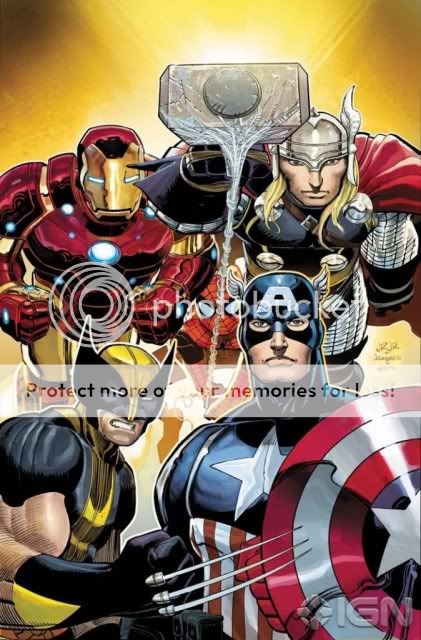
* Dan Nadel sure makes it sound like Ben Jones is doing an Adult Swim pilot…
* George A. Romero’s Survival of the Dead sounds pretty bad.
* How many of these killer little comics does Frank Santoro have socked away?
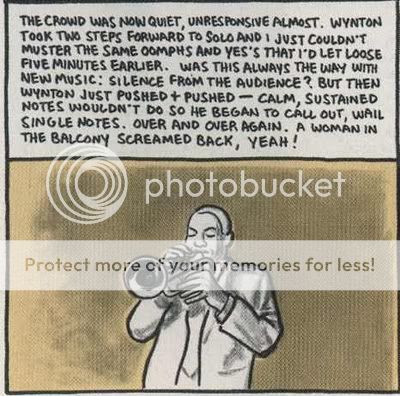
* Curt Purcell makes The Wolfman sound worth a matinee viewing.
* Jog takes a look at two recent Viz titles of note, Biomega and All My Darling Daughters.
* Dick Cheney loves torture so very much he just can’t shut up about what a war-crime perpetrator he is. I’m not even really exaggerating.
* Goldfrapp have the attitude every artist should have, both generally and about Van Halen specifically.
* Great job!
Comics Time: The Death of Superman
February 12, 2010
The Death of Superman
Dan Jurgens, Jerry Ordway, Louise Simonson, Roger Stern, writers
John Bogdanove, Tom Grummett, Jackson Guice, Dan Jurgens, Brett Breeding, Rick Burchett, Doug Hazlewood, Dennis Janke, Denis Rodier, artists
DC, 1993
168 pages
$9.99
Nostalgia is an occupational hazard for comics readers. Even as I write this, there’s a part of me that wonders how much of what I’m about to say is colored by the mere fact that I first read this material not as a 31-year-old, but as a 14-year-old, with a 14-year-old’s understanding of the industry and artform of comics. But honestly? I’m thinking “not much,” because the 31-year-old likes this comic a lot more than the 14-year-old did.
For example, back then I was deeply unimpressed by the motley crew of losers who made up the Justice League at the time, and who were really the stars of the show in the initial issues of this storyline. They’re a parade of weak designs and goofy powers, from Guy Gardner’s bowl haircut and leather jacket to Blue Beetle’s beetle-shaped spaceship Booster Gold’s superpowered spandex outfit to a character named Fire who is inexplicably green, not, you know, fire-colored. At least Ice looks icy. There’s some B-plot mystery involving a ’90s-tastic goofball named Bloodwynd (look at that ‘y’!) whose word balloons drip blood, there’s a woman warrior named Maxima who is to other, better superheroines like Wonder Woman and Phoenix what one of those cheapo greatest-hits collections you can get in a five-dollar bin at the grocery store is to the overall recording career of Johnny Cash…Man, do these guys suck.
Superman himself fared little better with me. I mean, he’s Superman, he has that going for him, which is nice. But what a square, boring world he inhabited at the time! The first issue collected here sees him face off against a bunch of underground monsters who talk like Cookie Monster and present just about as much of a convincing threat. There’s the usual horrible street-dialect comics writers of yore subjected any blue-collar character to–you know, “ta” instead of “to” and a lot of “in'”s instead of “ings.” Gross. Finally, Superman’s big character moment before the action starts is a TV interview in which they reveal a hidden power of his: The ability to avoid saying anything remotely interesting. He offers a politician’s focus-group-tested, studiously bland and inoffensive answers to questions about his role as the obviously most awesome guy in the Justice League, his recent fight with asshole Guy Gardner, the fact that Maxima looks and dresses like a swimsuit model, and so on. If the writers had set out to make him unappealing to teenagers, they couldn’t have done a better job.
And ultimately, 14-year-old me ended up sharing much of the conventional fan wisdom about Superman’s beating death at the hands of the monstrous new enemy Doomsday. Doomsday wasn’t a character, he was a plot device, created for the sole purpose of killing a character who basically couldn’t be killed. (DC would repeat this trick later with Bane and Batman, introducing a huge dude to beat the unbeatable hero.) Lex Luthor got gypped. It wasn’t a story, it was a mere slugfest, not the Shakesperean tragedy that would befit such a momentous occasion. Though I hadn’t read any of them other than The Dark Knight Returns, I was aware of the medium’s artistic masterpieces, such as Watchmen, Crisis on Infinite Earths, and Camelot 3000–did not Superman deserve a send-off of their caliber? Finally, by the time the hype died down, Superman came back to life with long hair (remember, no one used the m-word back then), and it became apparent that my multiple unopened polybagged copies of the actual death issue weren’t going to be putting me through college, I just plain felt ripped off. Instead of six copies of the Death of Superman comic, I wished I bought just one of that awesome Death of Superman t-shirt.
That last part I still agree with. The rest? Oh, to be that young and naive again! Because I’ll tell you what–I wish we could get an event comic as rollickingly entertaining as The Death of Superman today.
Viewed with some distance, read in the comfort of my marital bed rather than my parents’ basement, stacked up against the many many many many comics I’ve read since then, I find that most of my teenage complaints are flipped on their head. Okay, so the dialogue stinks, there’s really no bones to be made about that. (Seriously, people give Bendis a hard time over his tics, I know, but superhero comics have truly seen a quantum leap in the craft of creating believable, entertaining human speech.) But take that crappy Justice League (please!): It’s their very crappiness that makes the book so entertaining in its early going, when the action consists of nothing more or less than Doomsday pounding them into unconsciousness over and over again. If I recall correctly, Doomsday’s rampage effectively ended this era of the team, a consummation devoutly to be wished. It’s a perfect blending of an in-story plot with a meta need, i.e. to lose these losers. I could read page after page of Blue Beetle lying prone on a pile of rubble begging for help or Maxima getting tossed around like a sack of potatoes and never ever get tired of it.
And page after page of people getting the stuffing knocked out of them is exactly what you get, which leads to my next point: An action-comics event consisting almost entirely of action is a great idea, but as we’ve recently learned, it can be difficult to convincingly pull off if all you do is have big spreads with dudes shooting lasers in all directions in the middle of nowhere, punctuated by approximately one memorable action beat per issue. In The Death of Superman, laser blasts are kept to a minimum, and when they’re fired, they’re all pointed in one direction at one guy: Doomsday, who just stands there and takes it. Most of the rest of the action is fisticuffs, a pure slobberknocker. Doomsday has a simple goal: Keep moving and keep destroying. Superman and friends have a goal that’s just as simple: Stop him. In that basic set-up we have a sense of directionality, a readily understandable concept of what victory or defeat for either side looks like, and a simple way to root the combat in the immediate physical presence of the combatants.
I’m also now struck by how smartly staged the action can get. Doomsday’s less a villain than your basic rampaging monster, and thus the creative team sets him loose in time-tested rampaging-monster fashion, having him smash his way through everyday environments like a highway, a Wal-Mart, a suburban neighborhood. You picture something like this happening near where you live and quickly get a sense of how friggin’ cool it would look. In addition, Doomsday’s always moving, which gives the fight a propulsive momentum, but when he does get bogged down for a time by Superman or the Justice Losers, the creators make skillful use of that particular place–in the suburbs, a single mother bickers with her teenage son until Doomsday lobs a knocked-out superheroine through their kitchen window and eventually lights the whole house on fire; near the headquarters of the Jack Kirby-created Cadmus Labs, Superman and Doomsday fight in a giant technoorganic Ewok village whose treelike structures they bring clattering down like Lincoln logs; the final stage of the fight is just a bareknuckle brawl in the middle of the street outside the Daily Planet, which location they quickly reduce to a slag heap. In each case, you get a sense of where you are and what’s happening to it. Action has consequences.
Doomsday himself, moreover, is a great design. In the comic, he starts out in an all-over green jumpsuit and mask, festooned with looping binders, that obscures his bony spikes and monstrous face. He looks like a square-bodied Kirby creation run amok. But as the fight progresses, his outfit is torn away, revealing the very ’90s everything-more-awesome-than-everything-else spikes and claws and so on we’ve come to know. One of those allegorical Kurt Busiek/Alex Ross/Brent Anderson Astro City character designs couldn’t have done it better. Superman’s thoughts throughout the fight are a stand-in for our own: a dawning realization that yeah, this guy could succeed where everyone else failed.
In the end, that success (albeit pyrrhic–Doomsday “dies” too) comes suddenly. The final four issues of the story famously “counted down” from four panels per page to three to two, until in the climactic issue the story is told entirely through splash pages. What’s exciting about this to me now is that it’s hard to imagine a comic doing that today, simply because splash pages aren’t storytelling devices, they’re pin-ups and future original art sales revenue. But the Jurgens/Breeding team actually does things with those one-panel-per-page images other than “here, look at this awesome pose!” They awkwardly shift Superman’s body around: For every shot in which he’s flying menacingly at the viewer, there are several more where he’s being hurled into a helicopter, or where he slams into his opponent upside-down, or where he’s driven by his feet headfirst into the concrete. The angle shifts dramatically as well, and the bold transitions–from a worm’s-eye-view behind Doomsday’s legs to a medium shot of Doomsday from the front getting punched in the back to a ten-feet-overhead view looking straight down at Superman as he heat-visions Doomsday into the side of a building, for example–create an unpredictable, gripping flow. On the page in which the two fighters ready what will be their final blows, there are no grand gestures or profound interior monologues; the last thing Superman thinks before receiving a mortal injury is just “I’ve got to put this guy away while I still can!” (“This guy”!) Yeah, it’s a little awkward that the tableaux of grief with which we are presented are Ma and Pa Kent, Lois Lane and Jimmy Olsen, and…Bloodwynd and Ice, but the melodrama of that final image–Lois crying to the heavens with her hands twisted into tense claws, Superman lying stretched-out and slack-jawed in the rubble, his tattered cape fluttering off of some nearby rebar like a flag, Jimmy snapping one last photo (from the rear, but I assume he got the angle right eventually)–is a miniature model of body language, jagged edges, and superhero spectacle. And hey, lookit that–that’s not a bad way to describe the whole book.
Carnival of souls
February 12, 2010* Christopher Handley will do six months in prison for the crime of being mailed comics. He joins Mike Diana in America’s thoughtcrime hall of shame. More here.
* Today on Robot 6: King-Cat: The Motion Picture and Iron Man Was Right.
* Brian Chippendale on Taiyo Matsumoto.
* Let the games begin!
Carnival of souls
February 11, 2010* I interviewed Marvel’s Tom Brevoort at length for Robot 6 today. Tom’s a fascinating figure and I really enjoyed speaking with him.
* Also at Robot 6 today: Bill Ayers and Frank Miller are headlining MoCCA. Cue Odd Couple theme song!
* Incredible Hercules is being relaunched as Prince of Power in a way that would be spoilery were I to describe it to you, but I’m betting you can guess even without clicking. It’s funny–I interviewed Brevoort just a few days ago, but in the interim, two of the three series I cited as examples of critically acclaimed titles Marvel couldn’t get to stick have been relaunched. Again, I’m glad to see Marvel supporting books like Herc and Atlas…and I’m hoping Captain Britain & MI-13 gets revived for the hat trick.
* Very lively discussion in my latest Lost Thoughts comment thread. This was a controversial episode! Related: Todd VanDerWerff’s follow-up/round-up posts are starting to look like they’ll be as interesting as his actual reviews.
* Robert Kirkman talks about the upcoming, long-time-coming Invincible storyline The Viltrumite War. As this is basically the “Who Killed Laura Palmer?” for this series, it should be interesting to see how Kirkman navigates it and transitions the series out of it at the end.
* Aquaman’s back and Geoff Johns’s got him! That sounds good to me.
* Tom Spurgeon has the last word on conservative mau-mauing of Ed Brubaker’s Captain America.
Carnival of souls
February 10, 2010* Todd VanDerWerff was more patient with last night’s Lost episode than I was, and I think he’s largely convinced me, though I feel like we sort of need to see how things go in the next few episodes to see if this was laying the groundwork for something or just sort of anomalous. Ryland Walker Knight, by contrast, was even more dismissive of it than I was, though I think his characterization of it as feeling very Season Three was accurate. Again, though, we’ll see where things go.
* After its world tour of crossovers with the X-Men, the Avengers, Thunderbolts, and Incredible Hercules, Agents of Atlas is returning as just-plain Atlas. Hooray! I’m happy to see how hard Marvel worked on this book’s behalf, the apparently soon-to-be high profile of Gorilla Man being a good example.
* I really like the idea of War of the Supermen, the next big DC event, taking place over the course of 100 minutes. If the creators involved really work on packing those 100 minutes of battle in terms of memorable physical beats that are easy to follow from one to the next, it could really be something.
* Ta-Nehisi Coates on “the death of hip-hop”–this passage was a real eye-opener:
When I was a kid, I thought only better (lyrically) things would follow. I think that was a function of me not really understanding why most people were listening to hip-hop. Sure some of us obsessed over the words, but Dre basically had it right–“Ya’ll don’t wanna hear me, you just wannna dance.” That’s basically been the case from jump. Great lyrics were a beautiful and important side-effect, but a side-effect nonetheless.
Sad but true?
Comics Time: Monkey & Spoon
February 10, 2010
Monkey & Spoon
Simone Lia, writer/artist
AdHouse, 2004
pages
$9.95
What a pleasant book this is! I’ve loved it for a long time. It’s nothing more or less than a little scene about a husband-and-wife sock monkey and a doll made from a spoon who fight and then make up, but the specifics are just nailed. The book begins with a long wordless stretch as the couple fix a meal, with pointed silences and angry glances galore. When they finally start talking, each word is freighted with a day’s worth of frustrations and perceived slights, and every choice of phrase is belabored until it loses all meaning other than “WE’RE FIGHTING”: “This is pathetic ” “Pathetic? Is that what you think when I say something? It’s pathetic?” “I didn’t say that. You’re twisting my words.” Lia really gets the timing of how people talk when they’re arguing, too–I particularly loved how the monkey jumped on the spoon’s first soft-spoken statement with an all-caps “PARDON?” But soon enough a crisis intervenes, and the two instantly drop their hostile facades to attend to one another’s more pressing needs; once those have passed, they both remain in a safe enough emotional space to apologize for their bad acts and reach out to one another again. In my experience that’s how fights with the person you love work: Things can get as nasty as you’d expect when you’ve got a whole life together from which to draw your ammo, but it’s ultimately that life together that matters, and usually some part of you is just waiting an excuse to deactivate your offensive weapons and reconnect. Lia’s twee-crude line and character designs prove surprisingly resilient and effective in communicating such finely observed points, and providing big grin-provoking physical beats in the process. This book has a goal and meets it with precision and panache. Here’s your Valentine’s Day gift, Amazon Prime members.
Lost thoughts
February 9, 2010SPOILER ALERT
SPOILER ALERT
SPOILER ALERT
* How did Kate find Claire after ditching her? Why the hell would a woman 36 weeks pregnant decide to be besties with the woman who terrorized her with a gun to her head and stole all her shit? Why would two of Lost‘s most experienced writers throw a credibility-destroying development like that into one of the show’s final episodes?
* I’m pretty impressed that even after all these years, they’re still finding ways to have the Others do heinous shit but still leave open the possibility that it might almost kinda sorta be justified. I just wish people would remember that the fact that Destro fought Cobra Commander once doesn’t make him a good guy.
* So…the Others really are nominally servants of Jacob, but occasionally their Lazarus Pit turns people evil? Which most of them act like anyway? I guess we’ll get this ironed out eventually.
* Sawyer just saying “fuck it all” at this point makes a lot of sense. Josh Holloway’s handling it well. It’s funny, though: The Missus asked me toward the end of the episode “So why is Kate chasing after Sawyer now?” and I had no idea.
* Always fun to see Ethan. What great casting William Mapother was! The first of many, many compelling villains on this show. (Or the second, considering how Locke was initially handled.) It took me a minute to accept that hey, he’s not evil here, things worked out pretty good for ol’ Ethan Goodspeed in a world without the Island.
* And see, before anyone starts, I can accept synchronicity, as in Ethan being the doctor who delivers Claire’s baby. That’s how the world of the show works. I can accept smoke monsters and an immortal guy in eyeliner (I think that’s a Grant Morrison character, actually)–that’s how science fiction and fantasy work. If they’d worked a little harder to show that Kate finding Claire was a function of one of those things, fine. But they didn’t. Neither character seemed the least bit fazed by Kate pulling up to that bus stop, beyond a “Oh great, this lady again” look from Claire. It sure wasn’t a “What the fuck, how did this person find me again?” look. I’m pretty much stunned it got on the air. Oh well, maybe this means they got the rotten episode out of their system early on and it’s smooth sailing from here on out.
Lost clues!!!!
February 9, 2010“Ou sont les bagages? Ou est le voyageur?”
Monty Python was already asking the big questions!!!
Carnival of souls
February 9, 2010* I’d really like to see Ed Brubaker use Baron Zemo vis a vis Bucky Barnes the way he used the Red Skull vis a vis Steve Rogers over the past few years. I mean, it makes sense.
* I’ve been having fun watching Matthew Yglesias mercilessly beat down torture enthusiast Marc Thiessen and torture enthusiasts generally, because torture is wrong and those who support it are bad people. I’ve also been having fun watching Andrew Sullivan dance around the f-word when describing the political impulses embodied by Sarah Palin.
Carnival of souls
February 8, 2010* Today on Robot 6: Avengers-related news galore (let’s hope Secret Avengers is Brubaker espionage), possible glimpes of the Marvel Universe’s post-apocalyptic future, someone got Wizard wet, and Benjamin Marra’s awesome Traditional Comics commercial.


* Sometimes I feel like I discover stunning new comics art from somewhere on the medium’s spacetime continuum every single day. Today it’s the gorgeously static work of Pete Morisi, courtesy of Ken Parille.
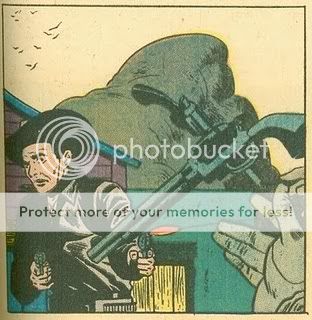
* The Cool Kids Table’s Comics Decade has come to an end with Scott Pilgrim, Black Hole, and cosmic comics.
* Charles Hatfield on Abstract Comics, at length, with a detour into Henrik Rehr’s excellent Reykjavik. The bit I found most interesting is Hatfield’s discussion of which shapes tended to make him tune out–I had a very similar experience, though with very different shapes.
Comics Time: The Book of Genesis Illustrated
February 8, 2010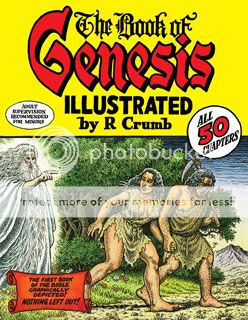
The Book of Genesis Illustrated
R. Crumb, writer-artist
Adapted from Genesis: Translation and Commentary and The Five Books of Moses by Robert Alter
W.W. Norton, 2009
224 pages, hardcover
$24.95
Captivating, illuminating, at times laugh-out-loud funny, and almost belief-beggaringly gorgeous, R. Crumb’s ambitious adaptation of the Bible’s first and foundational book hit pretty much every note I wanted to hear from such a project.
For starters, as a showcase of Crumb’s drawing chops–masterful even in his old(er) age–it’s tough to top. I’m aware of the criticism that it could have been subtitled Beards on Parade, and I reject that criticism, or rather I invert it: the beard parades were among the best parts! And they’re perhaps the most emblematic sections of the entire book, in that they boil Crumb’s project down to its essence. Genesis’ long multigenerational tale of the patriarchs of the Israelites and their large extended families necessarily includes a lot of hirsute dudes in Cecil B. DeMillian garb, and at times even substitutes litanies of their names for any actual story or plot. So what you get during the long lists of sons or what the back cover jocularly refers to as “The ‘Begots'” is a bit like folding one of Crumb’s sketchbooks into a comic. As the generations rattle by, Crumb draws scene after one-panel scene depicting some family activity at random: A mother nurses and laughs as her other son runs past playing; another mother breaks up a fight between two kids; people dance and drink at a party. At other times he’ll simply insert postage-stamp panel portraits of each person, inventing them out of whole cloth, and the act of reading becomes a master class in how many variations of the human face can be captured by one artist. In each case, through Crumb’s attention to detail, mastery of crosshatching and stippling, and rock-solid carved-from-clay character construction, an entire life, and the world that surronds it, is suggested in the space of a panel.
And that’s pretty much what made the whole book so very appealing to me–another litany, that of the keenly observed and impeccably depicted moments that take the musty, revised, translated, censored, edited, politically motivated, at times inspired, frequently batshit bizarre text of the world’s most important religious document and make it something fun to read. Gimli-like Abraham, never looking his (not-firstborn, not only!) son Isaac in the eye as he leads the lad to the slaughter. The denizens of Sodom, portrayed not as a bunch of mincing homos, but rather as a predatory pack of grinning good-time assholes. The destruction of Sodom and Gomorrah, portrayed in a stand-out layout of three widescreen panels that arrange contorted bodies and black and white spaces in a manner suggestive of an un-abstract David B. The close-up on Lot’s face as he begs God to let him hide out in a nearby town rather than force him to take a dangerous journey even further away from the soon-to-be-destroyed cities, his wild eyes matching the desperation in his repeated assertion that “it’s such a little place!” The moving, teary-eyed embraces during the rapprochements of sundered brothers Jacob & Esau (a development I’d entirely forgotten about) and, later, Joseph & his eleven brothers. Esau dancing up a storm. The random brutality with which Crumb depicts “the wickedness of the human creature” that inspired God to flood the Earth. Shem, Ham, and Japheth drawn as Shemp, Larry, and Moe. The hoary cliche of God as a white-robed, white-bearded, white-haired old man put to graphic use as his flowing locks and whiskers become an elemental thing, echoing the radiance of the sun or the force of the rain and wind. The easy physical intimacy of Adam & Eve and Isaac & Rebekah romping, or Isaac & Rebekah cuddling on their wedding night. The sexiness of Tamar dressing up as a temple harlot, or Rachel presenting her handmaid Bilhah to Jacob, or “that scene” with Onan and Tamar. Reinforcing Joseph’s ruse that he doesn’t recognize his brothers by presenting his speech to them in hieroglyphics and then using a translator to relate them. The “do what now?” looks in the eyes of everyone who must get circumsized. The shocked sideways glance Eve shoots Adam as he throws her under the bus. The serpent as an anthropomorphized He-Man villain, until God curses him to crawl on his belly.
I am not a believer, and thus I appreciated the rough edges of the original text that a project like this brings out–the repeated pimping out of people’s wives to save their own skin; the polygamy and incest (Where’s your traditional marriage now, Moses?); God’s nutso caprice throughout the entire enterprise; the frequent brutality and deception employed by God’s chosen ones; the complete absence of monotheism as a concept, complete with gods mating with human and producing superhero hybrids; and so on. So if you’re the kind of person who insists that a comic of this nature must reveal the pure-dee lunacy of using these stories as the basis for the self-developed narrative of mainstream Western religious tradition, let alone as a basis for a moral code, let alone as the literal history of the world that way way way too people mentally carry with them when they enter the voting booth, you’ll make out fine.
But at the same time, the material is treated dead-on and respectfully, like “a straight illustration job” as Crumb puts it in his introduction. No cheap shots, no ironic image/text juxtapositions, no playing up the ugliness or contradictions. Rather you have a sympathetic treatment of these characters as people. Reading it, I got a taste of the solace evangelicals draw from these stories, and the entire cottage industry of “see, the people of the Bible are just like you!” sermons and books and so on that draw on them, if only to fit everything into a “so just believe in the God of the Trinity Broadcasting Network and everything’s fine” mold after the fact. That part’s absent, and instead you have a lively, living look at ancient stories that still retain their power to surprise, delight, enrage, and entertain. It’s a hugely successful comic.
Carnival of souls
February 5, 2010* Amazon’s having a huuuuuuge Lost sale. If you’ve never watched the show before, this is a great and relatively inexpensive way to catch up.
* Good gravy, this fellow Len Norris sure could draw. Just look at how the absence of gray magnetizes your eyes to those women. Yeah, the absence of gray is what does it, that’s the ticket. (Via Tom Spurgeon.)
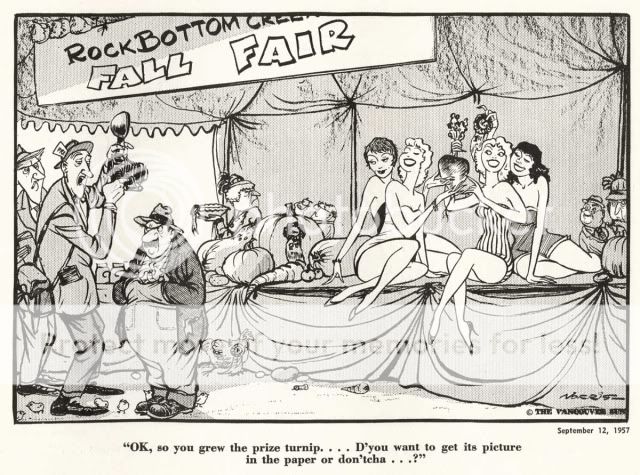
* Steve Ditko sure could (can?) draw too. Andrei Molotiu makes an STC-fave point about how you can use the motion of people and objects to physically describe, animate, and make real a space on the page. I sure do wish the artists of many of today’s big action comics were forced to read these panels prior to sitting down at the drawing table.
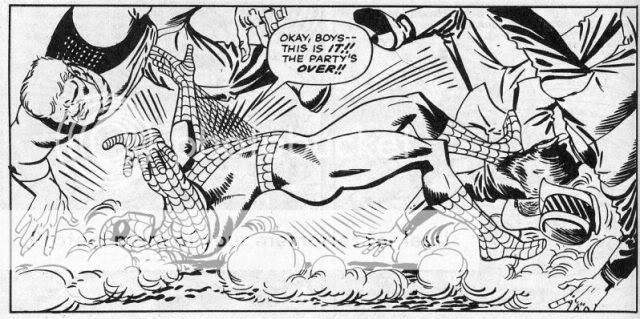
* A trio of impressive things by the Closed Caption Comics crew.
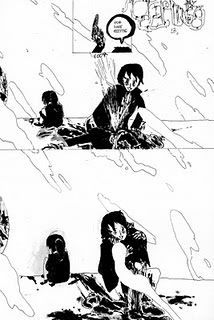


* “No, I’m Death, pure and simple.”
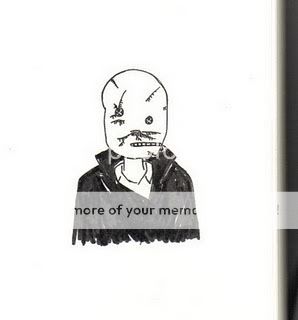
* Today on Robot 6: C2E2 & Anaheim’s guest lists and Rick Veitch’s soul.
Comics Time: Mercury
February 5, 2010
Mercury
Hope Larson, writer/artist
Atheneum, 2010
240 pages
$9.99
Hmm.
Okay, first of all, can we talk about what a lovely package you’re getting for $9.99? That cover is a killer, and Larson’s luminous line does nothing if not radiate “look at how beautiful this comic you’re reading is!” with every glance. Her blacks shimmer and shine, and her characters’ eyes glow like Influence in an old Chester Gould Dick Tracy. Seeing her art employed in a tale of familial and romantic teen angst up North gives the impression of a Craig Thompson with control instead of ecstasy as the key ingredient. For a measly $9.99, a price point even many tankubon volumes appear to have abandoned by now, the tween and teen girls who are Mercury‘s target will be getting a lot of art-object bang for the buck.
As for the story, I’ll be honest: Going into this thing, I was ready to be at a loss coming out of it. I have zero experience with YA fiction for girls, and very little with YA fiction for boys, even when I was a YA myself; there’s a degree of critic-proofing that that genre and that demographic lacquers on to any project. I was prepared to come away saying “Well, I see what’s going on here, and I’m guess it will/won’t work for its audience, but ultimately it’s not for me.” The critical white flag in other words.
And sure enough, there’s some YA stuff that fell a little flat for this less-than-YA. The period setting and attendant slightly stiffened dialogue, for example, are an obstacle that the earlier of the book’s two parallel plotlines have to work hard to overcome. I’m just not a bonnet-book guy, and unless you’re in a village that could potentially get raided by orcs, I don’t want to hear about how you have to finish your chores before Father returns from the market. To be less fatuous about it, I often find myself wishing that period fiction could just lose the dated dialect and have the characters speak like people today would, eschewing anachronisms but otherwise talking normally. I suppose you could always be a David Milch-level genius and devise, y’know, the best period speech ever, but barring that I feel like more is lost than gained with the distancing effect of the more formal speech–though to be fair, that’s often part and parcel of the stricter social codes that end up playing a huge part in the story, so perhaps that’s unfair. Meanwhile, the high-school setting of the contemporary half of the book is strangely sexless for a relationship-focused narrative; it’s funny to think of these characters as being in the same age group as the gang from Black Hole. A librarian who’d run screaming from The Diary of a Teenage Girl is going to have no trouble putting Mercury on the shelf, and that’s a sensible decision–and one for which Larson compensates with lots of finely observed detail regarding how teenage emotion can imbue everything from sleepover movie-watching to a pizza lunch with strange melancholy power. But it’s also not really the high school experience I remember. In books that deal in emotional truths, that’s a shortcoming, no matter how justified the sanitization might be.
But! No white flag here, no shrug of the shoulders and mumbling of “Eh, not my thing, but I bet your niece will like it, maybe.” Taken on the same terms as any other comic, Mercury is still an idiosyncratic, ultimately gutsy read. The kicker is the period story, about an itinerant prospector who finds gold on a farmer’s property and makes time with his teenaged daughter Josey while he helps the dad mine it. After a long rollout that has you suspecting the potential for heartbreak but not necessarily expecting it, takes a sudden and viciously sharp turn for the tragic, even the horrific. Thinking about its denouement now, I’m suddenly reminded of a sequence in, of all things, Louis Riel, that’s how severe Larson is willing to get here. But what ruins the lives of the characters in the past sets up a much better life for the characters in the present, specifically Josey’s teenaged descendent Tara, left with her aunt and uncle and trying to find her way among the public-school kids her single mother took her away from for homeschooling when a nasty divorce screwed her up. I won’t get into exactly how, but Tara’s happy ending, thoughtfully only teased rather than spelled out, is a direct result of the terrible misfortune that befalls Josey. I suppose you could read some sort of pat “circle of life, sunrise sunset, strikes and gutters, ups and downs” kind of message into that, but I saw it as a tougher, more bracing idea: that actions have consequences that reverberate down the line for decades, even centuries, enough to change entire lives. For an age group that tends to see everything, except perhaps the SATs, as somehow both all-encompassing and utterly in-the-moment, confronting the idea of legacies, unexpected ones at that, is stinging stuff.
But riding shotgun is the notion that in a world that works like that, you should take your happiness where you can get it. That’s what Tara does over and over: she forces herself to overcome her jitters and befriend the cute boy she meets, she hunts for the things that will improve her life, and–she has no way of knowing this, but of course Larson definitely does–she doesn’t allow the tragic legacy of her forebears to prevent her happy ending. None of this is handed to you with neat parallels or telegraphed transitions, by the way: I’m still teasing it out, and I’m glad that’s what I have to do.
Carnival of souls
February 4, 2010* Holy Moses, they’re screening a 145-minute uncut version of Clive Barker’s Nightbreed! The Holy Grail has been found! The quest has been fulfilled!
* Today at Robot 6: cool Paul Hornschemeier/Holy Consumption prints and debunking the Wizard/Watchmen 2 connection.
* NeilAlien provides a history lesson on the comics blogosphere.
* A fascinating Tom Spurgeon review of the fascinating ’80s-underground minicomix anthology Newave!
* Jesse Moynihan is putting his quite good webcomic Forming on hiatus while he takes a day job and plans for future installments.
* Jeet “The Real Deal” Heer (that’s what I like to call him) tracks parallels between the state of comics and the state of still photography. I wonder what the era of Terry Richardson and Last Night’s Party will produce?
* Did you know that comics publisher Sparkplug has a blog?
* FourFour’s Rich Juzwiak pounds the stuffing out of…Small Wonder?
* Further Lost thoughts from TV blogging’s indispensable man, Todd VanDerWerff. Check the comments for an interesting and to my ears accurate accent-related observation I noticed during my re-watch with the Missus last night, and for some details about a certain couple I missed entirely until I saw such comments online.
* Coming soon: What The–?! goes to the winter games.
One last SPOILERY Lost thing
February 3, 2010SPOILER ALERT
When Juliet first comes to at the bottom of the pit, she’s all upset, she tells Sawyer “it didn’t work,” that she hit the bomb but they’re all still stuck on the Island. Later, after Sawyer removes the big beam pinning her down and gives her a hug, she’s suddenly all smiles, she says “Let’s get coffee sometime–we’ll go Dutch,” she kisses him, says she’s got something important to tell him, and then dies, but Miles says she was gonna say “It worked.” Seems to me that the line about the coffee is something she will say to Sawyer in the alternate reality, and somehow she knows about its existence and that’s why she said it worked after all.
Carnival of souls
February 3, 2010* The best Lost reviews/recaps I’ve found are by Ryland Walker Knight at The House Next Door and House veteran Todd VanDerWerff at the LA Times’ Show Tracker.
* I’ve been looking forward to this ever since I helped set it up: Chris Mautner interviews Brendan McCarthy about Spider-Man: Fever and sundry other things.
* Wow, Tim Goldsworthy appears to have severed his working relationship with James Murphy and the DFA. Or vice versa. And this may have been going on for some time. They were the dance act of the decade for me.
Further Lost thoughts
February 3, 2010SPOILER ALERT. SPOILER ALERT. SPOILER ALERT.
* Initial, mostly silly thoughts here.
* I’m told that Maggie Grace initially had a film commitment, but that the show was ultimately able to work something out with all the actors they wanted to return for the final season. That’s really terrific news. Longtime readers know how much I hate the kind of situation where they have to create Frankie Pentangelli because Richard S. Castellano wanted too much money to return as Pete Clemenza.
* Thus it’s safer than ever to assume that Mr. Eko will be back. And I’m guessing my theory that he’ll link up with Jin and the Paik organization in some way will pan out too.
* Regarding Juliet’s double-dip death, I assume the thinking was that they couldn’t just bring her back as a dead body, that would be weird. They needed to give Elizabeth Mitchell something to do rather than just use a dummy or whatever.
* But mainly, this sets up Sawyer as the season’s most intriguing character. I’m hoping he becomes a really scary guy, that we get some full on Sawyer berserker attacks. They actually did one off-screen last night, after all.
* It’s never made sense to me that the time-travelers’ clothes transport with them. If it’s something about how anything in contact with you goes too, fine, but a) what about their shoes, those would only be touching their socks, most likely, and b) where do you draw the line? How much of the atmosphere comes with them, or the ground, or whatever? Oh well, I think we can give the show a pass for not being sticklers for pseudoscientific accuracy that would necessitate constant nudity. You can leave that to my fanfic, the title of which Nick Hornby stole for his latest book.
* Just yesterday I was telling someone I was looking forward to the inevitable Biggest Smoke Monster Attack Ever this season. I didn’t expect it to come in the very first hour! Pleasantly surprised. Also, I guess Fake Locke = Monster = Man in Black is settled law now, though I imagine people will still be searching for zebras after seeing this particular set of hoofprints.
* It was entertaining to see Hurley given some agency, above and beyond “Hi, I’m the audience identification character that the creators identify as such at every opportunity.” It didn’t feel fanservicey, either–it wasn’t the creators saying “Hey fans, now YOU get to be the hero!” I also enjoyed the way he just rolled with Jacob telling him he’d died an hour ago. You gotta get up pretty early in the morning to find a way to weird Hurley out at this point.
* I was surprised how entertained I was by the alternate timeline material. Here’s a case where the only thing weird about these sequences is the fact of their existence–there really aren’t any other genre staples to speak of, at least not yet. In that sense it’s very much a return to the tone of the Season One flashbacks, back before the science fiction, fantasy, and series-mythology elements seeped into pretty much everything. The way they sustained interest, besides the basic “hey look, it’s that guy!” stuff, was through attention to detail: the marshal getting up to retrieve the briefcase that had knocked him out from the overhead bin; playing with whether or not Locke would be in a wheelchair; some nice Rose/Bernard business; Locke still being a weirdo; Locke and Boone connecting; and so on. Little nods in the direction of things that were important way back when, bringing things full circle.
* They threw in some head-scratchers, too, of course. With Desmond on the plane and Shannon and Jack’s dad’s body not on it, we’re left to wonder how divergent the timelines really are. We don’t know if there’s added significance to Jack’s recognizing Desmond beyond their earlier meeting in that stadium, or to Charlie’s statement that he was “supposed to die” beyond junkie melodrama. We don’t know if Desmond really disappeared, or just went back to his original seat. And in a show that pays this much attention to detail, I even wonder why Sawyer and Charlie’s haircuts were so different.
* When Sayid came to and started talking, I tried to determine whether or not he sounded different–mostly meaning if he started speaking in Michael Emerson’s cadence. After all, Richard had said way back when they used the Temple to save young Ben after he was shot by Sayid that if they did this, Ben would never be the same. Sayid’s got the same wound, was treated in the same way–what’s different about him now? Is he now a vessel for Locke or Jacob?
* I’m not 100% convinced we’ll never see Actual Locke or Actual Sayid again. It seems to me like the show would want to make it clear whether these characters died a “good death” or not. I don’t see it as the kind of show that lets a good guy die believing he’s going to Hell.
* I sure am hoping we’re moving toward a “save the world from the Smoke Monster Man in Black” plotline. I fully support the Man in Black getting off the Island having the narrative significance of Sauron getting the Ring back.
(Thanks to Matthew Perpetua, Ben Morse, Kiel Phegley, and TJ Dietsch for the conversation.)
Comics Time: Night Business #3
February 3, 2010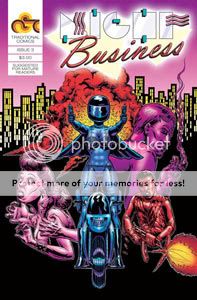
Night Business #3
Benjamin Marra, writer/artist
Traditional, January 2010
24 pages
$3
Buy it from Traditional Comics
About the Author:
Benjamin Marra is an artist who lives in the city. He is utterly and completely passionate about art. “Art … consumes me,” says Marra, “It is a part of my soul. When I look at a painting on the wall and I see a brush stroke, I can see the universe in it. I spend a lot of my time in galleries and museums looking around at the artworks. I like to see what’s going on in the art scene, you know, see what the new concepts are in art, see what my colleagues are up to.”
–from Night Business #3
The above text is pretty much what I love about Night Business in a nutshell. It’s simply a perfect encapsulation of a teenager and/or shut-in’s idea of what the City is. Artists who refer to themselves as such going to galleries and museums to stay on top of the activities of their cutting-edge colleagues. The glamorous, high-paying world of stripping and stripper management. Pimps who squirrel away a small army of thugs in warehouses filled with wooden crates and barrels of gasoline. Cops who thought they’d seen it all learning they haven’t, not by a long shot. One good man, pushed to the limit, taking a stand for what’s right and to hell with the consequences. Streetlight people, oh oh oh.
I don’t have the first two issues in front of me, but my impression is that this is the strongest yet on several levels. The insistent, grandiose stupidity of the writing reaches a delirious pitch here, my favorite example being the no-nonsense gun-toting would-be rapists who accost a pair of women on a thoroughfare broad and bright enough to be 14th Street: “Hey, ladies!! Are you looking for a party?!” “Hah, yeah! Are you looking for a party?! You’re invited to our party!” “We’ve got your official party invites right here! Don’t move.” “Scream and you die.” The pacing’s pretty sweet too, with the climactic fight between Johnny and the aforementioned warehouse full of thugs staged with one beat per panel, like the drum intro to “Big Bottom.” It ends with a glorious pin-up of Johnny flying through the air as he escapes an explosion, with knowingly wonky foreshortening, neatly symmetrical bursts of smoke and flame, and shiny inking showing off Marra’s studiously hidden chops despite himself. I’d kill to hang that page on my wall, let me just tell you. I’m all about seeking pleasure in comics these days, and this comic gets me off but good.
Lost thoughts
February 2, 2010SPOILER ALERT
SPOILER ALERT
SPOILER ALERT
SPOILER ALERT
SPOILER ALERT
* And the Deadwood Cast Relocation Program continues! Please welcome Sol Star, ladies and gentlemen. John Hawkes, please say hello to Kim Dickens, Paula Malcomson, William Sanderson, Robin Wiegert, and Titus Welliver when you get the chance. Meanwhile, break open the fuckin’ canned peaches, because I’m starting the Countdown To Ian McShane right here and right now.
* On a related note, I’m not all that worried about the hapless Oceanic employee who had to inform Jack that his father’s body was missing, because that guy’s accustomed to getting spooked:
* I’m pretty impressed by a television show that can maintain that “whaat..thee…hell?” feeling for a full two hours. So…divergent timelines, and the overlap is the whispering sound?
* Just very very nice to see Claire and Charlie and Boone and Rose and Bernard again. Even fanservicey old Frogurt and Arzt made me chuckle. I take it that negotiations with Maggie Grace broke down, however.
* Pulling for Mr. Eko’s L.A. drug connection to be the recipient of Mr. Paik’s watch.
* “I’m sorry you had to see me this way.” Smokey, takin’ us for a ride on the LOLicopter!
* Nice little shadow-and-light homage to Apocalypse Now and Col. Kurtz. I think I’ll enjoy crazy evil Locke-esque person.
* The second they slowed down to give us a glory shot of the Temple, I knew we’d get a “so, I guess this is the Temple” line from Hurley and would then cut to commercial. Sure enough!
* Rough of them to double-dip on the death of Juliet. I think we sort of have to wait and see where Sawyer goes from here to judge the effectiveness of that move. If he turns into a full-fledged monster, that’d be something.
* Cindy! Cindy! Cindy! Cindy! C-C-C-Cindy and the kids!
* I suppose the big question is whether Jack recognizes Desmond because their meeting at the stadium where they both were practicing running still happened, or because the Jack of this timeline is somehow able to remember what went on with the Jack of the other timeline.
* Haircuts are not consistent throughout the timestream, as it turns out.
Carnival of souls
February 2, 2010* On Sunday night I went to a very cool, very swanky, very funny fundraiser held by the stars and writers of Saturday Night Live to benefit the forthcoming stage/multimedia adaptation of Phoebe Gloeckner’s all-time-great graphic novel The Diary of a Teenage Girl. Here’s the report I did on the event for Comic Book Resources. Your takeaway should be that you should read The Diary of a Teenage Girl and go see Hannibal Burress and John Mulaney do stand-up if you get the chance.
* John Porcellino is blogging. Long Live the King. (Via Tom Spurgeon.)
* Hot damn, a new Jaime Hernandez Love & Rockets digest. Those books are the perfect blend of form and function. Scott Pilgrim fans, you have your instructions!
* My comics compadre Matt Wiegle did a 24-hour comic. Liz Bailie, MK Reed, Sally Bloodbath, and pie factor in.
* Gaze upon the face of your destroyer.
* Lost‘s final season begins tonight, and so…
* Lost Links #1: Noel Murray’s pondering of the show at the Onion A.V. Club contained a paragraph that spoke to some of my feelings about the show:
On the other hand, I’m not sure that the mythology is the heart of the show either–at least not for me. I dig the mythology more than the Sawyer/Kate/Jack/Juliet love quadrangle (and I do have questions I want answered), but I primarily love Lost for its thematic concerns and ambitious genre-play. I’ve already talked about how much I get out of the predetermination/freedom business, but I also like that Lost has always been a celebration of storytelling, from the arcane to the archetypal. It’s a genre-hopping story that pays direct homage to nearly every text that’s ever influenced its creators. It’s one long story, made up of a bunch of little stories. It’s a story about how backstories encroach and affect the main narrative, whether it be via time-travel or flashbacks (which are a kind of time travel). And, finally, it’s a story about the repetition of stories, and about which elements can be altered and which can’t.
In the past I’ve said something not identical, but similar: I watch the show not as an exercise in puzzle-solving, but as an exercise in genre that does everything genre can do, very very well: sex and violence, mystery and horror, awe and adventure, heroism and villainy, the literature of ideas, genre elements used as a sort of crucible for character development. Rather than the thematic or philosophical concerns that intrigue Murray, though, I prefer the individual character stories insofar as they deal with what people do when confronted with failure.
* Lost Links #2: In this colloquy between three TV critics–the Chicago Tribune’s Maureen Ryan, the Newark Star-Ledger’s Alan Sepinwall, and Time’s James Poniewozik–this passage stood out:
Poniewozik: Unfortunately, there’s this [problem] that’s inherent to sci-fi shows that “Battlestar Galactica” ran into.
In a regular, character-based drama, maybe people have high expectations for the finale, maybe they expect that closure from it, or [maybe they expect it to] wrap up in a certain way for the characters. Even when it’s a finale that people really don’t like — the “Seinfeld” finale, the “Sopranos” finale for a lot of people — I don’t know that many people who said, “I hate this ‘Seinfeld’ finale so much that it ruined the show for me.”
But there’s a thing about sci-fi that they expect the finale is not just supposed to be a narrative ending. It’s supposed to be an Answer, which to me is kind of ridiculous. The finale is supposed to say what it all meant, what everything was about. And you know, I’m not saying that it’s unimportant. I watch these shows for the same reason, but if the show is really good, that’s secondary.
Ryan: Well, I really felt like there was a left-brain, right-brain split in a way, when it came to the reaction to “Battlestar.” I’m obviously being overly reductive, but it seemed like there were two sort of realms of fan responses or reactions. There were the people that wanted the whole mythology to add up correctly and make sense, and there were the people who wanted the character stuff to kind of wrap up. I was mostly in the latter camp. And so for me, I felt like there were a couple of wobbly things in the finale, but I was willing to live with them because the “Battlestar” finale really delivered, for me, on a character level.
Whereas, in the post-finale comments I was seeing, people wanted the math to add up. You know, like, the show is a math equation and the show needed to get the right answer. And in my mind, it was never going to do that — I necessarily didn’t expect that or think it was going to be possible for it all to add up neatly. I felt like, this is a show that has taken many risks. A few of them have not paid off, but I’d rather watch a show that does something crazy that has an 89 percent chance of working out down the road, story-wise, than a show that plots things out in a way that is purely logical and kind of clinical.
I don’t have much to add to that. (Via LOSTblog.)
* Lost Links #3: Here’s a cute idea from Topless Robot’s Kevin Guhl: ranking the season premieres and season finales by their openings and cliffhangers respectively. I think the openings list is more or less right on, though I would have given top honors to the pilot episode, because that harrowing opening sequence is what sold the world on the following six seasons. The cliffhanger section is sort of weird, though–he doesn’t seem to actually like any of them.
